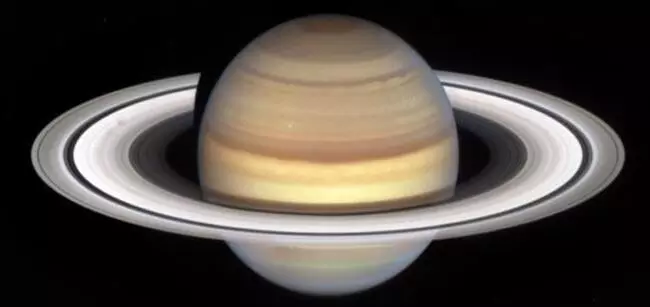
Start of a new Saturn 'spoke' season captured by NASA's Hubble
text_fieldsWashington: The formation of spokes on Saturn's rings in the most recent photograph of the planet taken by the Hubble Space Telescope of the National Aeronautics and Space Administration (NASA) signalled the beginning of a new "spoke" season, the agency said.
According to the announcement, scientists will search for hints that will help them understand the origin and makeup of the spokes.
The planet's fluctuating magnetic field is thought to be the cause of the spokes, according to the statement.
Planetary magnetic fields interact with the solar wind, creating an electrically charged environment.
On Earth, when those charged particles hit the atmosphere this is visible in the northern hemisphere as the aurora borealis, or northern lights, NASA said.
Scientists think that the smallest, dust-sized icy ring particles can become charged as well, which temporarily levitates those particles above the rest of the larger icy particles and boulders in the rings, NASA said.
Like Earth, Saturn is tilted on its axis and therefore has four seasons, though because of Saturn's much larger orbit, each season lasts approximately seven Earth years, the space agency said.
The equinox occurs when the rings are tilted edge-on to the Sun.
The spokes disappear when it is near the summer or winter solstice on Saturn, which is when the Sun appears to reach either its highest or lowest latitude, respectively, in the northern or southern hemisphere of a planet, the space agency said.
As the autumnal equinox of Saturn's northern hemisphere on May 6, 2025, draws near, the spokes are expected to become increasingly prominent and observable, the statement said.
The latest image captured by Hubble is heralded the start of Saturn's "spoke season" with the appearance of two smudgy spokes in the B ring, one of the rings, of Saturn, the statement said.
The ephemeral features don't last long, but as the planet's autumnal equinox approaches, more will appear, the statement said.
The ring spokes were first observed by NASA's Voyager mission in the early 1980s. The transient, mysterious features can appear dark or light depending on the illumination and viewing angles, the statement said.
NASA senior planetary scientist Amy Simon, head of the Hubble Outer Planet Atmospheres Legacy (OPAL) program said, "Thanks to Hubble's OPAL program, which is building an archive of data on the outer solar system planets, we will have longer dedicated time to study Saturn's spokes this season than ever before." NASA's Hubble Space Telescope has observation time devoted to Saturn each year, thanks to the OPAL program, and the dynamic gas giant planet always showed something new, said the space agency.
Saturn's last equinox occurred in 2009, while NASA's Cassini spacecraft was orbiting the gas giant planet for close-up reconnaissance, the agency said in the statement.
With Cassini's mission completed in 2017, and the Voyager spacecraft long gone, Hubble is continuing the work of long-term monitoring of changes on Saturn and the other outer planets, the space agency said.
"Despite years of excellent observations by the Cassini mission, the precise beginning and duration of the spoke season is still unpredictable, rather like predicting the first storm during hurricane season," Simon said.
While our solar system's other three gas giant planets also have ring systems, nothing compares to Saturn's prominent rings, making them a laboratory for studying spoke phenomena, the statement said.
Whether spokes could or do occur at other ringed planets is currently unknown, NASA said.
"It's a fascinating magic trick of nature we only see on Saturn - for now at least," Simon said.
Hubble's OPAL program will add both visual and spectroscopic data, in wavelengths of light from ultraviolet to near-infrared, to the archive of Cassini observations, NASA said.
Scientists are anticipating putting these pieces together to get a more complete picture of the spoke phenomenon, and what it reveals about ring physics in general, the statement said.
With PTI inputs


















